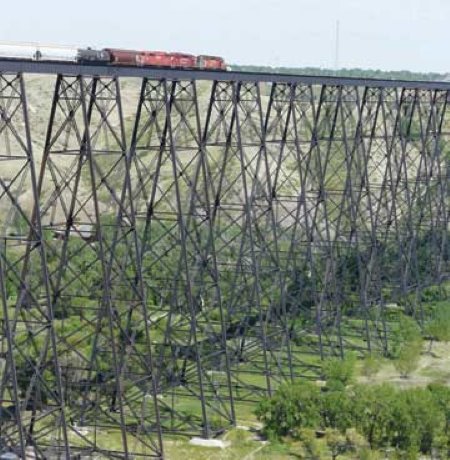Not only is it the world’s longest and highest railway trestle, but it may be the toughest, too. There are no restrictions on the length or weight of the mile-long freight trains that roll across the Lethbridge Viaduct a dozen times a day, even though the bridge is preparing to celebrate its 100th birthday in September.
Engineering History
World's highest and longest railway trestle turns 100 in September
LETHBRIDGE
Not only is it the world’s longest and highest railway trestle, but it may be the toughest, too.
There are no restrictions on the length or weight of the mile-long freight trains that roll across the Lethbridge Viaduct a dozen times a day, even though the bridge is preparing to celebrate its 100th birthday in September.
The High Level Crossing, as it is commonly known in Southern Alberta, is slightly more than a mile long at 5,331 feet and soars 314 feet above the Old Man River, which flows through a deep ravine on the west side of Lethbridge.
When the bridge opened for traffic in September 1909, its first transit was made by 100 townsfolk walking across on the railway ties.
There’ll be no pedestrians on the bridge during its official birthday party on Sept. 5, but thousands will gather to party in a park beneath the trestle and salute its grandeur, its endurance and its renown as an international engineering marvel.
John Edward Schwitzer, assistant chief of engineering at Canadian Pacific Railway, was in charge of erecting what many newspapers of the day called “one of the wonders of the world.”
Schwitzer was a busy engineer in 1907. While building the Lethbridge Viaduct, he was also in charge of engineering the famous spiral tunnels in the midst of the Rocky Mountains.
Those two almost circular tunnels, through two separate mountains, allow trains to rumble through the Rockies with full loads and at optimum speeds without confronting the notorious “big hill”.
The hill in Yoho National Park had a treacherous 4.4 per cent grade, which gave train operators nightmares and killed several in derailments, before Schwitzer’s spiral tunnels reduced the grade to 2.2 per cent.
Both of Schwitzer’s engineering feats are popular tourist draws 100 years later. A rest stop on the TransCanada Highway through Kicking Horse Pass has a bleacher-like viewing area where travelers watch long trains enter a mountain tunnel and emerge on the same side of the mountain with the locomotives crossing 55 feet above or below (depending on which direction they’re heading) rail cars at the end of the train, which had not yet entered the tunnel.
High Level Bridge is the principal icon of Lethbridge, a city 85,500 about 222 kilometres southeast of Calgary. It was built to eliminate 22 wooden trestles and 37 curves, reduce the grade level by half and cut fives miles off the route between Lethbridge and Fort MacLeod on CP’s southern line, which follows the Crowsnest Pass through the Rockies.
Before the high trestle was built for $1.3 million, locomotives had to reduce their loads to wind their way down into and out of both the Old Man River and St. Mary River valleys.
The 12,400 tons of steel girders for the bridge were manufactured by Canada Bridge Company at its Windsor plant and shipped on 645 railway cars to the east bank of the Old Man River valley.
Construction started in August 1908 and the 100-man crew finished erecting steel by June ’09, using a custom-built railroad crane, called an “erection traveler,” with a 116-foot boom. After tracks started protruding from the east bank the erection traveler was able to carry steel girders out over the deep ravine.
Thirty-three rigid steel towers carry the rail bed across the ravine. Schwitzer designed the towers to not only support the weight of trains passing overhead, but also to resist the steady winds sweeping out of the Crowsnest Pass.
Just west of Lethbridge hundreds of 15-storey wind turbines have been erected on ridges to harness those strong winds funneling through Crowsnest Pass.
Renowned American engineer C.C. Sneider was hired as a consulting engineer on the Lethbridge Viaduct. Sneider was elected president of the American Society of Civil Engineers in 1905 and was one of the engineers hired to erect the Statue of Liberty in 1886.
He also headed up the team of engineers that investigated the 1907 collapse of the first Quebec Bridge, when 75 bridge builders were killed.











Recent Comments
comments for this post are closed